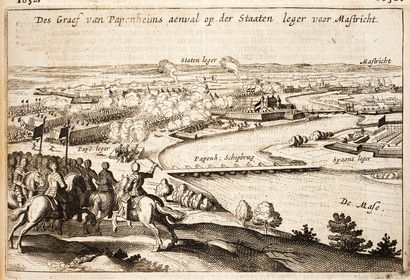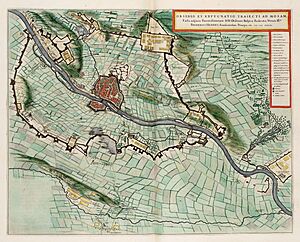Capture of Maastricht facts for kids
Quick facts for kids Siege of Maastricht |
|||||||
|---|---|---|---|---|---|---|---|
| Part of the Eighty Years' War | |||||||
 Frederick Henry enters Maastricht |
|||||||
|
|||||||
| Belligerents | |||||||
| Commanders and leaders | |||||||
| Besieged Relief forces |
Besiegers |
||||||
| Strength | |||||||
| Besieged 2,000 infantry 3,000 armed citizens Relief forces 18,000 infantry 6,000 cavalry |
Besiegers 17,000 infantry 4,000 cavalry |
||||||
The siege of Maastricht was an important battle that took place from June 9 to August 22, 1632. During this time, the Dutch commander Frederick Henry, Prince of Orange, led his army to capture the city of Maastricht from the Spanish forces. This event was a key part of the Eighty Years' War, a long conflict where the Dutch fought for their independence from Spain.
Contents
Why Maastricht Was Important
After a big win in 1629 at the Siege of 's-Hertogenbosch, the Dutch leader Frederick Henry, Prince of Orange decided to move his army along the Maas River in 1632. His main goal was to capture Maastricht. This city was a very strong fortress located deep inside territory controlled by Spain.
As Prince Henry's army moved south, some smaller fortified towns like Venlo and Roermond surrendered easily. This happened partly because Van der Bergh, a local leader, secretly supported the Dutch side.
Maastricht's Defenses
In 1632, Maastricht was protected by tall, old medieval walls with many towers. Some newer earth defenses, like bastions and demi-lunes, had been built to help protect against powerful cannons. A wide, flooded ditch, filled with water from the river, also guarded the lower parts of the city's defenses.
The city of Maastricht is built on both sides of the Maas River, which is quite wide there. This meant that any attacking army would have to split its forces, making the attack harder. The city's defenders, led by Guillaume de Bette, were very strong and loyal to Spain. They were determined to fight off the Dutch army. On top of that, there was a good chance that a Spanish relief army would come to help Maastricht.
The Siege Begins
Frederick Henry and his army arrived at Maastricht on June 10. He had about 17,000 foot soldiers and 4,000 cavalry (soldiers on horseback). Among them were experienced English and French troops, who played a big part in the battle.
Right away, Frederick Henry's army started digging huge earth walls around the city. These were called "lines of circumvallation" and "contravallation." They were built to protect the Dutch camps from attacks by the city's defenders or by any outside army trying to help Maastricht. These lines included various forts and strong points. Where the lines met the river, the Dutch built floating bridges. This allowed them to move troops and supplies easily from one side of the river to the other. The strength of these defensive lines was very important to the outcome of the siege.
Attacking the Walls
The Dutch army dug two main trenches, or "approaches," towards the city walls. One was dug by the English troops, and the other by the French. The English and French trenches aimed at different parts of the city's western defenses.
The French trench targeted an old medieval wall near the Brussels Gate, which wasn't well protected by other defenses. The English trench aimed just south of a demi-lune, a crescent-shaped defense, in front of the walls. Back then, attackers didn't dig straight parallel trenches. Instead, they dug zig-zag trenches and built strong points for their cannons.
Spanish Relief Efforts

To help Maastricht, Isabella, who governed the Spanish Netherlands, called back her troops. She sent Don Gonzalo Fernández and the Marquis of Santa Cruz to relieve the city. They arrived near Maastricht on July 2 with a large army of 18,000 foot soldiers and 6,000 cavalry. Even though they had more soldiers than Frederick Henry's army, they didn't attack the Dutch lines because they were so strong.
By early August, Don Gonzalo de Córdoba got even more help from an Imperial commander named Pappenheim. Pappenheim brought 12,000 foot soldiers and 4,000 cavalry. He decided to attack the Dutch lines to force them to stop the siege. Don Gonzalo made a fake attack on one side of the river, while Pappenheim launched a real attack on the other side. This plan was clever, but the strong Dutch defenses and the high spirits of Frederick Henry's troops (who were encouraged by his presence) won the day. Pappenheim was forced to retreat, losing 1,500 men. A Dutch commander, Robert de Vere, 19th Earl of Oxford, was also injured.
After failing to break the siege by force, Don Gonzalo and Pappenheim tried to cut off the Dutch supply lines. They hoped to starve the Dutch army out. However, the Dutch had enough supplies to last for two more months. So, Frederick Henry simply ignored them and continued the siege.
The Final Attack
The city's defenders fought very hard and made many surprise attacks, especially against the English trench. But eventually, both the English and French trenches reached the city's ditch. The Dutch decided to dig tunnels under the ditch and place explosives under the walls to create a hole.
One mine was set off under the walls. On the night of August 21, a small group of brave soldiers attacked the hole in the wall. They managed to get a foothold inside the city's defenses. The next morning, the city's defenders surrendered. They were afraid that if the attackers fully broke in, the city would be looted.
After the Battle
The defenders marched out of Maastricht with military honors on August 23. Pappenheim and Don Gonzalo, who were still camped nearby but running out of supplies, also left.
Frederick Henry's success in capturing Maastricht was a big blow to the Spanish. They even started talking about peace. However, their determination to fight grew stronger a few months later when the Swedish Protestant hero Gustavus Adolphus died at the Battle of Lützen on November 16.
Even though some other towns were lost to the Spanish later, Maastricht remained under Dutch control. This was a very important victory for the Dutch Republic. For a long time, control over Maastricht was shared with the prince-bishops of Liège.



